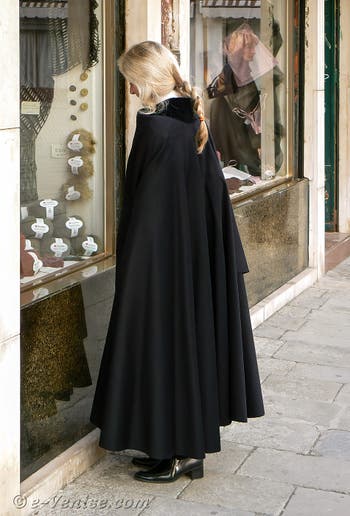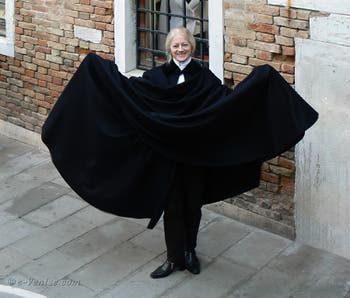Shopping Food Drink | Fashion | Carnival | Books | Glass Beads Jewels | Art Objects | Useful
Fashion Burano Lace | Gloves | Hats | Shoes | Friulans | Linen Fabric | Tabarro | Glasses
The Tabarro - The Venetian Cape in Venice

Daniela with her Tabarro The Tabarro is a long black cloak that you can drape yourself in for maximum protection from the wind, cold and rain. Its origins date back to the Greeks, Etruscans and Romans: the toga, for example.
In Italy, and particularly in the Venetian region, tabarro was worn by all levels of society, from peasants and merchants to noblemen and princes.
In fact, during their trip to Venice in 1782, the son of the Empress of Russia, Catherine II the Great, donned the tabarro to the great delight of the Venetians :
“The same people never ceased to applaud the honour the Count of the North seemed to be bestowing upon them, having donned the Tabarro himself.
I myself have seen good people pointing out this Prince to one another, saying: here he is, here he is; he is made like a Venetian, he wears a Tabarro; he is good, he is human no doubt, for he has donned the Tabarro.”
Comtesse des Ursins and Rosenberg - Du Séjour des Comtes du Nord à Venise - 1782
While simple and practical, the tabarro was nevertheless an outward sign of social belonging: the difference was not only in the quality and beauty of the fabric from which it was cut, but also in the finish and accessories.
The collar could be made of wool, velvet or astrakhan.

Daniela with her TabarroClosing hooks and brooches could be chased silver, or replaced with beautiful velvet cords for the ladies.
Finally, the lining was another sign of social belonging: blue for the “political” and red for the “religious”.
And the choice of hat was not insignificant either, as it completed the outfit with a personal touch.
The tabaro or tabarro has also entered the Venetian vernacular and when we say here “avoir un bon tabarro” it means “avoir de chance”.
in Venice, the original tabarro was also transformed into “domino”, a tabarro with a large bonnet under which ladies could better conceal themselves as they moved across bridges and Calli.
It was worn by Venetian women on their way to trysts, and by patricians whose company might have displeased the Council of Ten.
This is how these elegant, discreet figures roamed the Calli of Venice, well protected by their tabarro, which guaranteed them complete anonymity in the carnival period when worn with the tricorn and bauta (the white mask). In this way, the Tabarri covered bodies and... secrets.
Here is an account, dating from 1779:
“This Carnival, about which there is so much talk, and which does not end, since from the first days of October people go to the show in masks [...]
II consists of wearing a black coat, or Tabaro, a bahute, or domino of the same colour, which only covers the head and shoulders, a plain or plumed hat, and a white mask over the face, or in the horn of one's hat.”
Abbé Delaporte - Le Voyageur Français - 1779
This sign of prestige and power that was the long cape of the ceremonial habit was able to adapt to all lifestyles.
Monks and merchants, nobles and peasants and even brigands !
“The men are dressed like us and they only wear a coat, the Tabaro, which is usually of red or grey camelot, like our old French coats.”
Jérôme de La Lande - Voyage d'un Français fait en Italie - 1765
Everyone has worn the tabarro over time, right up to the cyclists of the twentieth century, who thus resembled large black birds flying low.
A few years after the Second World War, the tabarro was abandoned, as were the traditional clothes worn by fishermen in the Venetian lagoon and by farmers.
So much so that they were eventually forgotten.
Thankfully, in Mirano (a town on the mainland west of Mestre) in the early 1980s, there was an enthusiast for the history of his country's costume, Mr Zara, eager for information about the cut and fabrics of traditional garments.
Mr Zara, was also a passionate entrepreneur who wanted to maintain the quality craftsmanship of this Venetian fashion by relaunching the traditional tabarro on the market.
Unfortunately, tabarri had disappeared from circulation.
In order to recover the various types of tabarri still lying around in attics, Monsieur Zara had the brilliant idea of launching a rather tempting appeal to the Venetians:
“Bring me an old tabarro, and I'll swap it for a new jacket!”
Success guaranteed: Mr Zara ended up with all sorts of tabarri, cut from different waterproof fabrics, as many models as precious samples of fabrics that were no longer being made.

Daniela with her Tabarro As for the tabarri themselves, while their length could vary, the cut was always the same: the wheel.
The tabarro wheel could be provided by two half-circles of fabric sewn together at the back for the Çentesimi (the popular model), or four quarter-circle pieces of fabric for the Mercante Padano (merchant) with an Astrakhan collar.
The tabarro is a cape that falls in long folds along the shoulders thanks to the amplitude of its cut and the weight of its fabric, which is more or less thick and more or less lustrous and soft to the touch, depending on the model.
And when you want more protection from the wind, simply drape yourself in your tabarro by “doing” a cartwheel: you take a flap in one hand and throw it over the opposite shoulder, as you did with your toga.
In Venice you can buy tabarri from the House of Zara at Nicola Grillo, at the Magasin Store. Count 600 to 800€, depending on the quality of the tabarro.
The Store is located at 4260B, Rio Terra San Paternian in the District of San Marco in Venice, between Campo San Luca and Campo Manin.
The Store is open:
from Monday to Saturday, from 9:30 to 13:00 and from 16:00 to 20:00.
Telephone: +39 041 523 84 57
You can also buy tabarri from the competing brand “San Marco” at:
Monica Daniele
Calle Scaleter 2199
San Polo - 30125 Venezia
Telephone number : + 39 041 524 62 42
Fashion Burano Lace | Gloves | Hats | Shoes | Friulans | Linen Fabric | Tabarro | Glasses
Shopping Food Drink | Fashion | Carnival | Books | Glass Beads Jewels | Art Objects | Useful
Back to Top of Page

